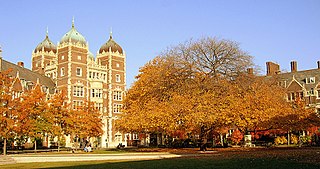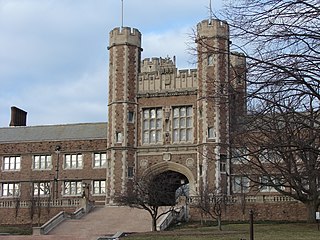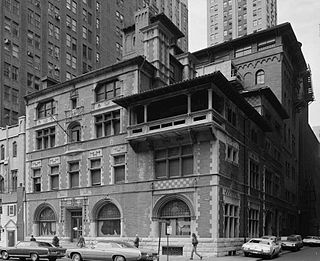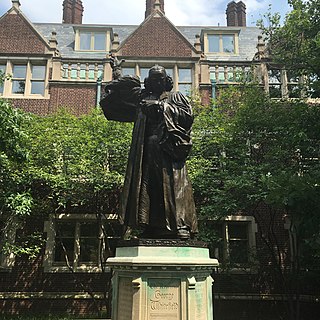
The University of Pennsylvania is a private Ivy League research university in Philadelphia, Pennsylvania. It is one of nine colonial colleges and was chartered prior to the U.S. Declaration of Independence when Benjamin Franklin, the university's founder and first president, advocated for an educational institution that trained leaders in academia, commerce, and public service. Penn identifies as the fourth oldest institution of higher education in the United States, though this representation is challenged by other universities, as Franklin first convened the board of trustees in 1749, arguably making it the fifth oldest institution of higher education in the U.S.

Cheyney University of Pennsylvania is a public historically black university in Cheyney, Pennsylvania. Founded in 1837 as the Institute for Colored Youth, it is the oldest of all historically black colleges and universities (HBCUs) in the United States. It is a member of the Pennsylvania State System of Higher Education and the Thurgood Marshall College Fund. The university offers bachelor's degrees and is accredited by the Middle States Commission on Higher Education.

Hobart and William Smith Colleges are private liberal arts colleges in Geneva, New York. They trace their origins to Geneva Academy established in 1797. Students can choose from 45 majors and 68 minors with degrees in Bachelor of Arts, Bachelor of Science, Master of Arts in Teaching, Master of Science in Management, and Master of Arts in Higher Education Leadership. The colleges have graduated 35 Fulbright Scholars, three Rhodes Scholars, and numerous Marshall Scholars, Rangel Fellows, Truman Scholars, Emmy, and Pulitzer awardees as well as United States senators, House representatives, and a United States Supreme Court justice. Hobart and William Smith Colleges is a member of the New York Six Liberal Arts Consortium, an association of highly selective liberal arts colleges. It is frequently ranked among the top 100 liberal arts colleges in the United States.
Charles Zeller Klauder was an American architect best known for his work on university buildings and campus designs, especially his Cathedral of Learning at the University of Pittsburgh, the first educational skyscraper.

Collegiate Gothic is an architectural style subgenre of Gothic Revival architecture, popular in the late-19th and early-20th centuries for college and high school buildings in the United States and Canada, and to a certain extent Europe. A form of historicist architecture, it took its inspiration from English Tudor and Gothic buildings. It has returned in the 21st century in the form of prominent new buildings at schools and universities including Cornell, Princeton, Washington University, and Yale.

Cope and Stewardson (1885–1912) was a Philadelphia architecture firm founded by Walter Cope and John Stewardson, and best known for its Collegiate Gothic building and campus designs. Cope and Stewardson established the firm in 1885, and were joined by John's brother Emlyn in 1887. It went on to become one of the most influential and prolific firms of the late-nineteenth and early-twentieth centuries. They made formative additions to the campuses of Bryn Mawr College, Princeton University, the University of Pennsylvania, and Washington University in St. Louis. They also designed nine cottages and an administrative building at the Sleighton School, which showed their adaptability to other styles, because their buildings here were Colonial Revival with Federal influences. In 1912, the firm was succeeded by Stewardson and Page formed by Emlyn Stewardson and George Bispham Page.

The Danforth Campus is the main campus at Washington University in St. Louis. Formerly known as the Hilltop Campus, it was officially dedicated as the Danforth Campus on September 17, 2006, in honor of William H. Danforth, the 13th chancellor of the university, the Danforth family and the Danforth Foundation. Distinguished by its collegiate gothic architecture, the 169-acre (0.68 km2) campus lies at the western boundary of Forest Park, partially in the City of St. Louis. Most of the campus is in a small enclave of unincorporated St. Louis County, while all the campus area south of Forsyth Boulevard is in suburban Clayton. Immediately to the north across Forest Park Parkway is University City.
University of Pennsylvania student life includes numerous events and social gatherings around campus, with some sponsored by the college.

Houston Hall is the student union of the University of Pennsylvania, in Philadelphia, Pennsylvania. Completed in 1896, it was the first student union built on an American college campus.

Brookings Hall is a Collegiate Gothic landmark on the campus of Washington University in St. Louis. The building, first named "University Hall", was built between 1900 and 1902 and served as the administrative center for the 1904 World's Fair. The first cornerstone was laid on November 3, 1900.

Perelman Quadrangle, also known as Perelman Quad, is an area of the University of Pennsylvania's campus in West Philadelphia that was redeveloped in 2001 in conjunction with a comprehensive renovation of Houston Hall. The renovation, performed by the architectural firm of Robert Venturi and Denise Scott Brown, also built a large open plaza formerly known as Wynn Commons, named for real estate businessman Steve Wynn. The name was changed to Penn Commons in February 2018 amid sexual misconduct allegations.

Frank Miles Day was a Philadelphia-based architect who specialized in residences and academic buildings.

Housing at the University of Chicago includes seven residence halls that are divided into 48 houses. Each house has an average of 70 students. Freshmen and sophomores must live on-campus. Limited on-campus housing is available to juniors and seniors. The university operates 28 apartment buildings near campus for graduate students.
College Houses are a major part of facilitating a community and experience amongst the undergraduates at the University of Pennsylvania. Each house has one Faculty Director and one House Director, with at least two College House Fellows in residence. Many houses host a range of jobs for students, including Residential Advisors, House Councils, Managers and Information Technology assistants. The houses also encourage communities through the wide range of Program Communities within the system.

Fifteen percent of University of Houston students live on campus. UH has several on campus dormitories: Moody Towers, The Quads, Cougar Village I, Cougar Village II, Cougar Place, and University Lofts. UH also has partnerships with three private complexes, Bayou Oaks, Cullen Oaks, and Cambridge Oaks.

Lathrop House was the third quadrangle dormitory built on Vassar College's campus in the town of Poughkeepsie, New York. Constructed in 1901 and designed by Boston-based Allen & Vance, the brick dorm stands five stories tall. Lathrop houses 180 students who may be any year or gender.

Edward Maene was a Belgian-American architectural sculptor, woodcarver and cabinetmaker.
The University of Pennsylvania College of Arts & Sciences (CAS) is the oldest undergraduate college at the University of Pennsylvania, a private Ivy League university, situated on the university's main campus in University City, Philadelphia. The college traces its roots to the establishment of a secondary school known as Unnamed Charity School in 1740. In 1749, Benjamin Franklin and twenty-one leading citizens of Philadelphia officially founded a secondary school named Academy of Philadelphia. In 1755, the secondary school was expanded to include a collegiate division known as College of Philadelphia. The secondary and collegiate institutions were known collectively as The academy and College of Philadelphia. The college received its charter from Thomas Penn and Richard Penn. Penn CAS is the oldest institution of higher learning in the state of Pennsylvania and the sixth-oldest chartered college in the United States.

The Reverend George Whitefield is a monumental statue which once stood on the campus of the University of Pennsylvania in Philadelphia, Pennsylvania, United States. Dedicated in 1919, it was designed by sculptor R. Tait McKenzie and honors its namesake George Whitefield, Anglican cleric who was a founder of Methodism. In 2020, in reaction to the George Floyd protests, the university administration removed the statue due to Whitefield's defense of slavery.

Edgar Fahs Smith is a monumental statue located on the campus of the University of Pennsylvania in Philadelphia, Pennsylvania, United States. The statue was designed by sculptor R. Tait McKenzie and honors its namesake, a former provost of the university.































